Safe even when using electromagnetic waves
DENBA is a technology that uses extremely weak electricity (electromagnetic waves) to gently vibrate water molecules inside food and human cells.
If a substance contains water, these vibrations can activate the water molecules and help maintain freshness for a longer period.
However, the term "electromagnetic waves" may cause concern or leave a negative impression for some people.
That is why correctly understanding what electromagnetic waves are will help people understand the safety of DENBA technology.
About the Frequency of Electromagnetic Waves
The frequency of electromagnetic waves refers to the number of wave oscillations per second. It is measured in Hertz (Hz). For example, if a wave repeats 10 times per second, its frequency is 10 Hz. The impact on humans can vary greatly depending on the frequency.
DENBA uses an extremely safe extremely low frequency (ELF) electromagnetic field, equivalent to the electromagnetic waves generated by a household 100V outlet.
This corresponds to the commercial frequency (50/60Hz) and contains no electromagnetic waves that could affect the human body.
Moreover, this frequency is far lower than that of microwave ovens or mobile phones, making it extremely safe.
The voltage is also low, and the output current is a very weak 0.02A. Normally, high voltage increases the risk of electric shock, but DENBA's low voltage makes it safe for the elderly, small children, and pets.
In addition to being safe, products applying the “freshness preservation” technology for food are also expected to help suppress oxidation in the body and support health maintenance.
DENBA's technology and products are backed by a strong track record and proven reliability, ensuring their safety and effectiveness for worry-free use.
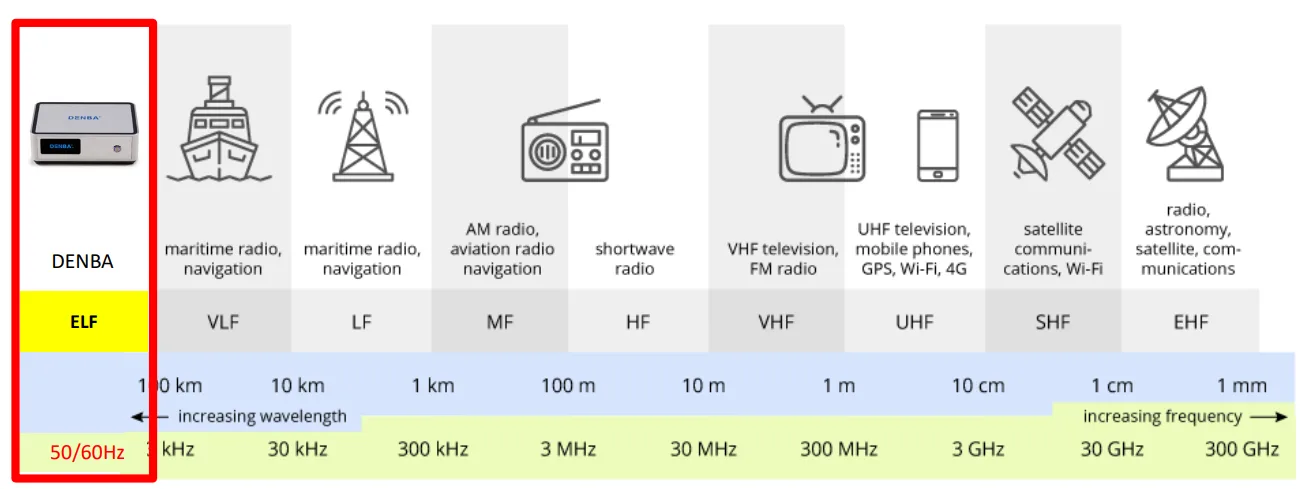
Visible "colors" are also electromagnetic waves
Looking at the diagram of types of electromagnetic waves above, extremely low frequencies are around 60Hz, and as frequency increases, they become radio waves. Radio, television, microwave ovens, and mobile phones all use radio waves, which are indispensable in our daily lives. With even higher frequencies, the waves enter the band called infrared. When people hear “infrared,” they may associate it with something beneficial to the body. In fact, infrared is also a type of electromagnetic wave. The rainbow shifts through seven colors from red to violet, and “infrared” means the color beyond red. From there, the spectrum enters visible light, and all colors we see are also electromagnetic waves.
Beyond violet lies the band called ultraviolet, and many people associate ultraviolet with harmful effects on the body. That is indeed the case, and it is said that frequencies as high as ultraviolet light (789THz or 789000000000000 hertz) can affect the skin and body. Above that, X-rays and gamma rays are known to be dangerous enough to damage cells.
On the other hand, if the frequency is lower, it passes through the body and is said to have no effect on it.
Even though they are all electromagnetic waves, they cannot be treated as the same; depending on the frequency band, some may have harmful effects, while others may have beneficial effects on the body.
Research studies on the beneficial effects on health
DENBA JAPAN Co., Ltd., the developer of the technology, promotes multiple joint research studies on the positive effects of DENBA on health through industry-academia collaboration with leading research institutions, aiming to return the research results to society.
Examples of Joint Research on the Positive Health Effects of DENBA
・The University of Tokyo × ITOCHU Corporation: Study on human autonomic nervous system function
・Keio University: Study on freezing/thawing of human iPS cells and cardiomyocytes derived from them, and discussion on efficacy
・University of Tsukuba: Study on effects on cognitive and motor function in the elderly
・Azabu University: Research on stress reduction in pigs and improved efficiency in growth and reproduction
・Suwa University of Science × Teikyo University: Usefulness of DENBA Health for improving driving performance
・Kamijo Women's Clinic: Solution for infertility treatment
Research Example ①
【World First】The University of Tokyo: Demonstrated increased autonomic nervous system activity with DENBA technology
Through a joint study by DENBA JAPAN Co., Ltd., the University of Tokyo professors, and ITOCHU Corporation, it was confirmed that approximately 15 minutes of electric field application using DENBA technology enhances the activity of the autonomic nervous system (both the sympathetic and parasympathetic nervous systems).
【Overview of the Demonstration Test】
This study initially focused on the activity level of the autonomic nervous system, which is associated with tension and anxiety and is known to change with aging and illness. To evaluate autonomic nervous system activity, heart rate variability (HRV) was used. The objective of the study was to objectively examine whether the short-term application of an electric field using DENBA technology affects autonomic nervous system activity.
Figure1: Effects of the electric field on HR and SDRR. SDRR increased significantly with electric field application.
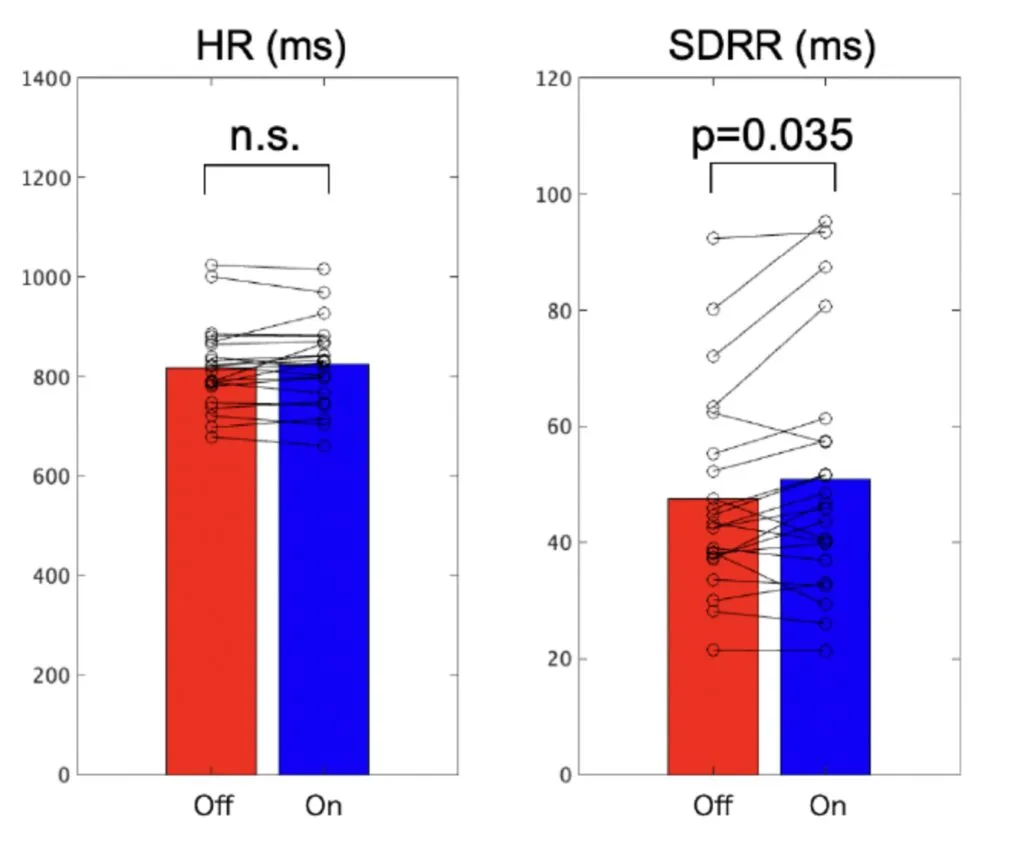
Figure 2: Power spectral density (PSD) of RR interval time series. The right panel shows the data in a log–log scale. PSD values are generally higher under the electric field condition.
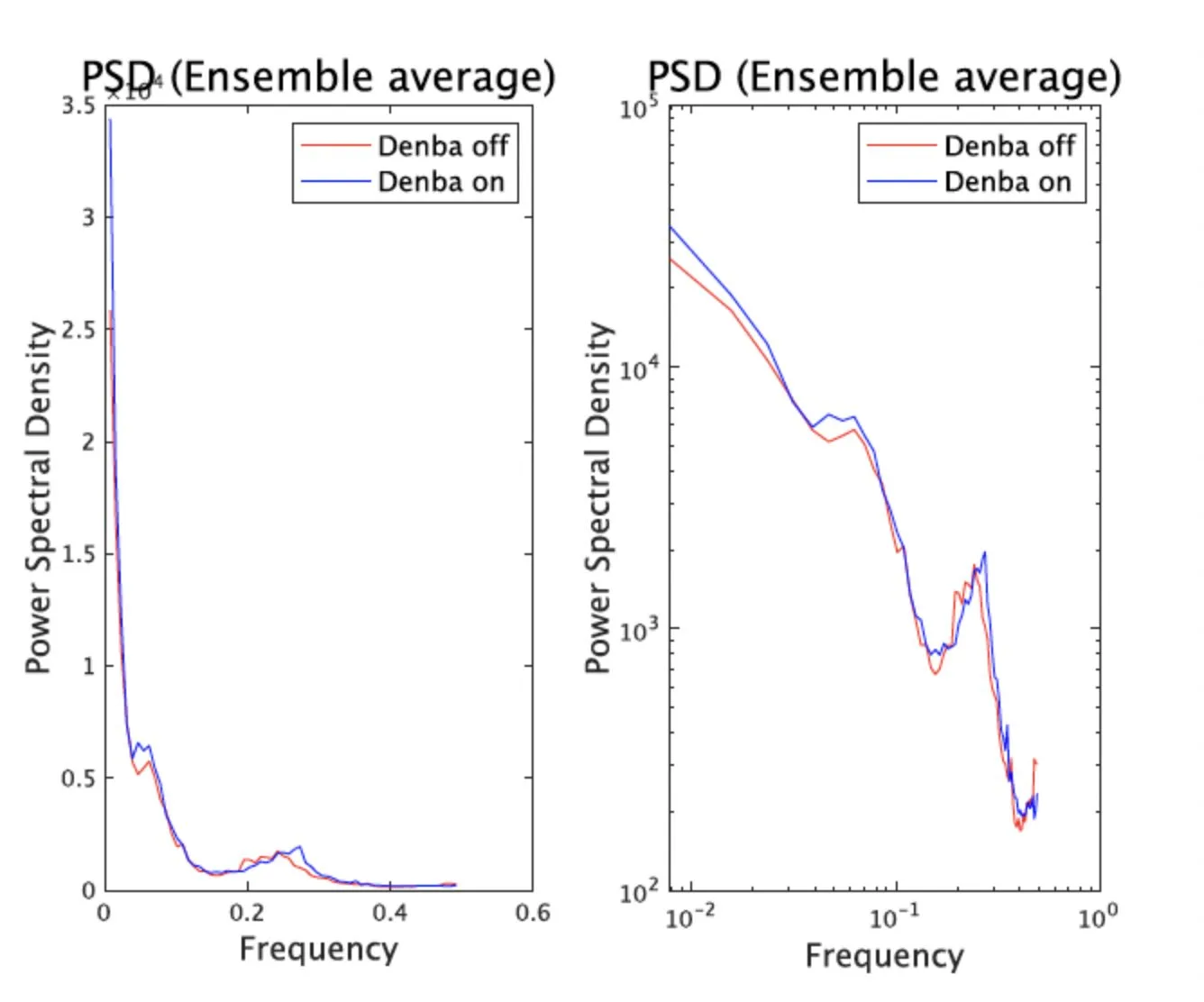
【Test Procedure】
① 22 subjects aged 20–56 sat quietly on a chair equipped with a DENBA mat for 60 minutes.
② The DENBA power was switched on and off every 15 minutes, out of sight of the subjects.
③ During this period, heart rate variability (HRV) was analyzed based on RR intervals obtained from recorded ECGs.
④ The subjects did not notice the switching of the weak electric field associated with the DENBA on/off operation.
⑤ Nevertheless, the standard deviation of RR intervals and both low-frequency and high-frequency components from power spectral density were significantly increased during field exposure.
⑥ As low- and high-frequency components reflect sympathetic and parasympathetic activity, respectively, the weak electric field from DENBA is likely to enhance autonomic nervous system activity.
(September 27, 2022)
Professor, Graduate School of Education, The University of Tokyo
【Profile of Professor Daichi Nozaki】
・Special Research Fellow, Japan Society for the Promotion of Science
・Postdoctoral Researcher, Department of Biomedical Engineering, Boston University
・Researcher, National Rehabilitation Center for Persons with Disabilities
Deputy Director, Center for Sports Science and Advanced Technology, University of Tokyo. His specialties include physical education science and the neural processes involved in motor control and learning.
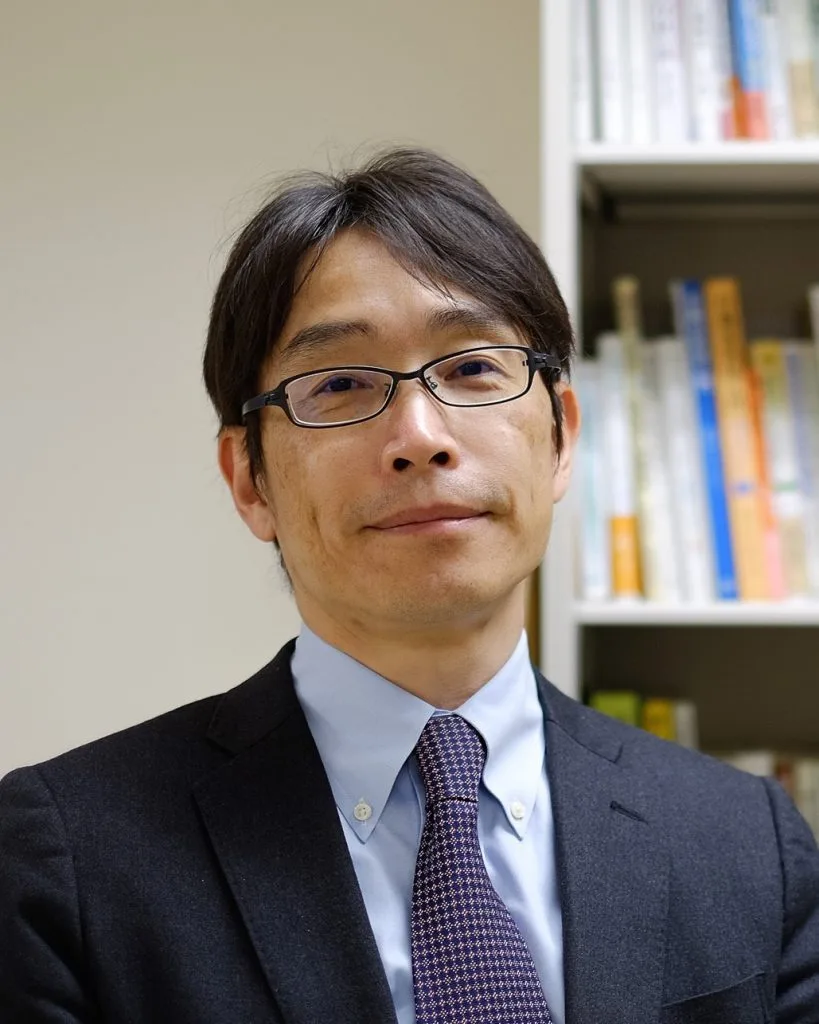
Research Example ②
Kamijo Women's Clinic: Solution for infertility treatment
A clinical study conducted jointly by DENBA JAPAN Co., Ltd. and Kamijo Women’s Clinic (Takasaki City, Gunma Prefecture) found that using DENBA minimizes damage to frozen–thawed embryos in infertility treatment and maximizes the inherent potential of the eggs.
At Kamijo Women’s Clinic, embryo culture and handling including freezing and thawing were performed under DENBA conditions, demonstrating minimal embryo cell damage and maximal utilization of each egg’s potential. While the national average in Japan for IVF embryo transfer resulted in a 21 % pregnancy rate and 15 % delivery rate, Kamijo Women’s Clinic achieved a 54 % pregnancy rate and 29 % delivery rate per embryo transfer using the DENBA spatial culture method. Even in frozen–thawed embryo transfers, pregnancy rates rose from 29.1 % to 38.5 % and delivery rates from 14.3 % to 22.0% after introducing DENBA.
*Kamijo Women’s Clinic, specializing in infertility treatment, presented these dramatic improvements in pregnancy and delivery rates for frozen–thawed embryos achieved through culturing enhancements using DENBA technology at the Japan Society for Reproductive Medicine meeting held on November 9–10, 2023.
【Research Findings】
Among women aged 25 to 46 who underwent frozen-thawed embryo transfers, pregnancy and birth rates were compared over two one-year periods: 237 cases before the introduction and 309 cases after, totaling 546 cases.

Pregnancy and Birth Rates in Frozen-Thawed Embryo Transfers
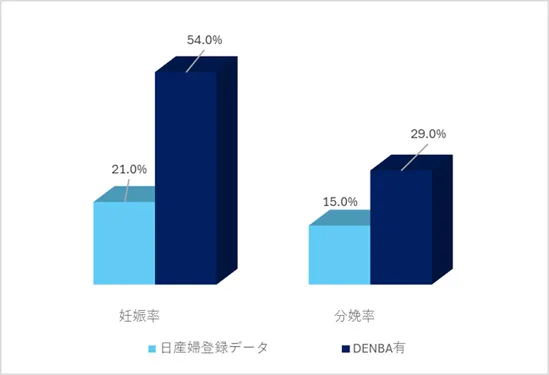
Pregnancy and birth rates in frozen-thawed embryo transfers significantly improved under the DENBA environment.
Pregnancy Rate 29.1%→38.5%
Birth Rate 14.3%→22.0%
Further applied to embryo culture in fresh embryo transfer (IVF-ET).
*Pregnancy and delivery outcomes from 300 IVF-ET cases conducted between March and December 2022.
\ Contact us now /
